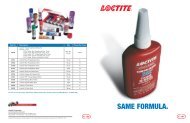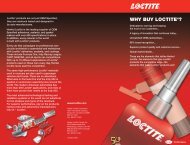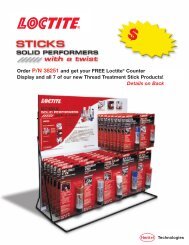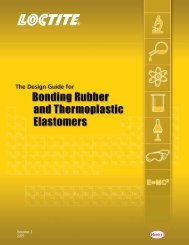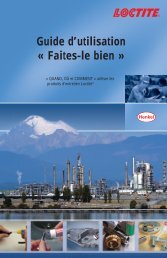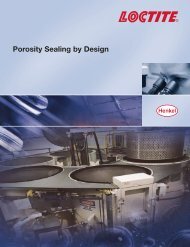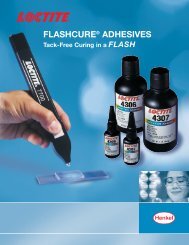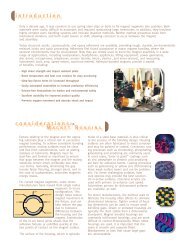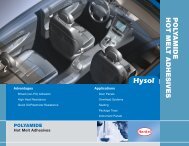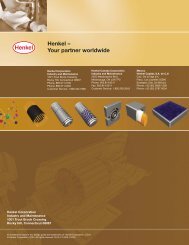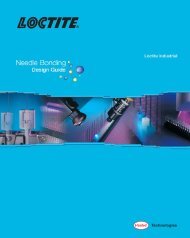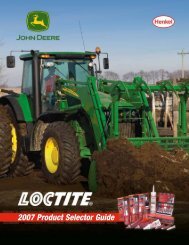Volume 4 - Loctite.ph
Volume 4 - Loctite.ph
Volume 4 - Loctite.ph
You also want an ePaper? Increase the reach of your titles
YUMPU automatically turns print PDFs into web optimized ePapers that Google loves.
Block Shear Test Method1. Assemblies were tested on an Instron 4204 mechanicalproperties tester, equipped with a 50 kN load cell, and a pullspeed of 0.05" per minute.2. Five replicates of each assembly were tested.TWO-PART STATIC MIX ADHESIVES(<strong>Loctite</strong> ® E-20HP Hysol ® Epoxy Adhesive, <strong>Loctite</strong> ® E-00CL Hysol ®Epoxy Adhesive, <strong>Loctite</strong> ® E-90FL Hysol ® Epoxy Adhesive, <strong>Loctite</strong> ®E-30CL Hysol ® Epoxy Adhesive, <strong>Loctite</strong> ® U-05FL Hysol ® UrethaneAdhesive, <strong>Loctite</strong> ® H4500 Speedbonder Structural Adhesive,<strong>Loctite</strong> ® H3000 Speedbonder Structural Adhesive,<strong>Loctite</strong> ® 3030 Adhesive, Polyolefin Bonder,<strong>Loctite</strong> ® Fixmaster ® High Performance Epoxy,<strong>Loctite</strong> ® Fixmaster ® Rapid Rubber Repair)1. The adhesive was dispensed onto the end of one block shearthrough an appropriate static mixing nozzle to achievethorough mixing of the two adhesive components.2. A second block shear was mated to the first withan overlap area of 0.5 in. 2 .3. The mated assembly was clamped with two clamps thatexerted a clamping force of approximately 20 lb.4. The bonded assembly was allowed to cure for one week atambient conditions before conditioning and testing.ONE-PART HEAT CURE EPOXY ADHESIVE(<strong>Loctite</strong> ® H-214HP Hysol ® Epoxy Adhesive)1. Adhesive was applied in an even filmto the end of one block shear.2. A second block shear was mated to the first withan overlap area of 0.5 in. 2 .3. The mated assembly was clamped with two clamps thatexerted a clamping force of approximately 20 lb.4. The clamped assembly was heated at350°F (177°C) for 1 hour.5. The assembly was left at ambient conditions for one weekprior to conditioning and testing.MOISTURE CURE PRODUCTS(<strong>Loctite</strong> ® 5900 ® Flange Sealant and <strong>Loctite</strong> ® 3631 Hysol ®Hot Melt Adhesive)1. Adhesive was applied in an even film to the end of one block shear.2. A short length of 10 mil thick wire was embedded in thesealant to induce a 10 mil gap between the bonded block shears(except for <strong>Loctite</strong> ® 3631 Hysol ® Hot Melt Adhesive).3. A second block shear was mated to the first withan overlap area of 0.5 in. 2 .4. The mated assembly was clamped with two clamps thatexerted a clamping force of approximately 20 lb.5. The mated assembly was allowed to moisture cure for oneweek prior to conditioning and testing.HOT MELT PRODUCTS(<strong>Loctite</strong> ® 3651 , 7804 and 1942 Hysol ® Hot Melt Adhesives)1. The adhesive was heated to its dispense temperature in theappropriate hot melt dispenser.2. Adhesive was applied in an even film tothe end of one block shear.3. A second block shear was mated to the first withan overlap area of 0.5 in. 2 .4. The mated assembly was clamped with two clamps thatexerted a clamping force of approximately 20 lb.5. The assemblies were left at ambient conditionsfor one week prior to conditioning and testing.The <strong>Loctite</strong> ® Design Guide for Bonding Plastics, <strong>Volume</strong> 4 87



